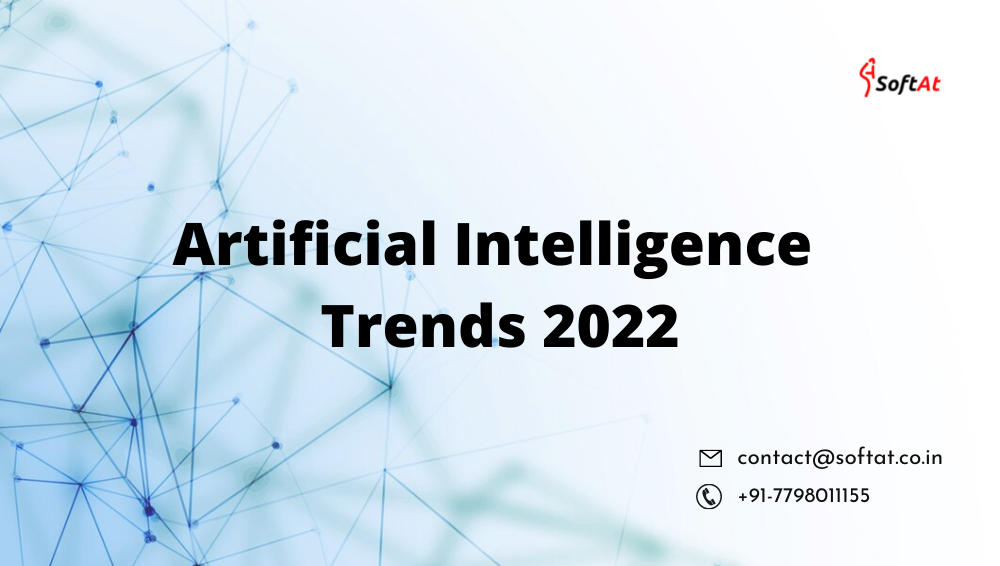Artificial Intelligence will continue on its way to becoming the most transformative technology humanity has ever created in 2022. According to Google CEO Sundar Pichai, it will have an even greater impact on our evolution as a species than fire or electricity. This may appear to be a lofty promise, but considering how it is currently being utilized to combat climate change, explore space, and find cancer therapies, the potential is undeniable. We will discuss the latest Artificial Intelligence trends in this blog.
The whole consequence of giving machines the ability to make decisions – and hence enable decision-making to occur considerably more swiftly and correctly than humans could possibly accomplish – is difficult to comprehend right now. But one thing is certain: discoveries and new technologies will continue to push the limits of what is possible in 2022.
Top Artificial Intelligence trends 2022
Language modeling: Bigger and Better
Language modeling is a technique that allows robots to comprehend and communicate with us in our own language – or even to convert natural human languages and convert them into computer code that can run programs and applications. We have recently witnessed the release of GPT-3 by OpenAI, the most advanced (and biggest) language model ever created, consisting of around 175 billion “parameters” – variables and datapoints that machines can use to process language. OpenAI is known to be working on a successor, GPT-4, that will be even more powerful.
Although no specifics have been confirmed, some speculate that it could contain up to 100 trillion parameters, making it 500 times larger than GPT-3 and, in theory, bringing it one step closer to being able to create language and hold conversations that are indistinguishable from human conversations. It will also improve its ability to write computer programs.
Computer Vision Technology in Businesses
According to a recent Gartner survey, computer vision is the most desired investment among firms that have previously invested in AI. According to the same survey, these businesses aim to invest an average of $679,000 over the following two years.
Computer vision is a branch of artificial intelligence that focuses on teaching robots to recognize and interpret images and movies. Machine learning algorithms in AI are typically trained on photographs in order to spot patterns and identify and classify things. It has a wide range of applications in a variety of sectors, including:
- Manufacturing—to visually inspect equipment.
- Healthcare—to analyze medical scans such as X-rays, CTs and MRIs.
- Autonomous vehicles—to detect obstacles, tracks and pedestrians.
- Agriculture—to use drones to monitor the conditions in fields and farms.
- Farming
AI and the Metaverse
The term “Metaverse” refers to a unified persistent digital environment in which people can collaborate and play together. It’s a virtual environment similar to the internet, but with an emphasis on allowing people to create immersive experiences. Since Mark Zuckerberg spoke about combining virtual reality technology with the social roots of his Facebook platform, the subject has been a hot issue. This is one of the most talked-about Artificial Intelligence trends.
AI will likely be a metaverse lynchpin. It will aid in the creation of online settings in which people can feel at ease while having their creative impulses nourished. We’ll also develop accustomed to sharing our metaverse habitats with AI creatures that may assist us with jobs or simply join us for a game of tennis or chess when we want to relax and unwind.
Autonomous vehicles
AI is the “brains” behind the self-driving cars, boats, and planes that will alter travel and society in the coming decade. When we look back in the future and reflect on how we thought it was normal that 1.3 billion people died in traffic accidents every year, 90% of which were caused by human error, 2022 should be a year to be remembered!
Tesla claims that its cars will display full self-driving capabilities by 2022, however, it is unlikely that they would be ready for widespread usage before then. Waymo (Google’s self-driving car), Apple, GM, and Ford are among its competitors, and any of them might disclose significant advancements in the coming year. The Mayflower Autonomous Ship (MAS), powered by IBM and designed in collaboration with non-profit ProMare, will attempt to cross the Atlantic again this year (having been forced to turn back during its initial attempt this year).
Creative AI
AI may be utilized to generate art, music, poetry, plays, and even video games, as we all know. We may expect more elaboration and seemingly “natural” creative production from our increasingly imaginative and capable artificial pals in 2022, as new models such as GPT-4 and Google’s Brain expand the boundaries of what’s possible. Rather than being demos or experiments to demonstrate AI’s potential, we will increasingly see them used in ordinary creative jobs in 2022, such as writing headlines for articles and newsletters, drawing logos, and creating infographics. Creativity is typically seen as a uniquely human quality and the fact that these talents are now being demonstrated in machines indicates that “artificial” intelligence is certainly approaching the somewhat hazy concept of “genuine” intelligence in terms of scope and function.
AI-Based Cybersecurity
The World Economic Forum last year recognized cybercrime as posing a greater threat to society than terrorism. Hacking and cybercrime will unavoidably become more of an issue as machines take over more of our life because every connected device you add to a network is a potential point of failure that an attacker could exploit. Identifying those sites of failure gets more difficult as networks of linked devices become more sophisticated. However, this is where AI can help. Smart algorithms are increasingly playing a role in keeping us secure from 21st-century crime by studying network data and learning to spot patterns that imply bad intentions.
Why is AI trending in 2023?
Artificial intelligence (AI) is trending in 2023 for a number of reasons. Here are some of the most important ones:
- The increasing availability of data: AI algorithms need data to learn and improve. In recent years, the amount of data available has exploded, thanks to the growth of the internet and the proliferation of sensors and other devices that collect data. This has made it possible to train AI algorithms on much larger and more diverse datasets, which has led to significant improvements in performance.
- The development of new AI techniques: In recent years, there have been a number of major advances in AI techniques, such as deep learning and reinforcement learning. These techniques have made it possible to build AI systems that can perform tasks that were previously thought to be impossible, such as playing games at a superhuman level and generating realistic images and text.
- The falling cost of computing power: The cost of computing power has been falling steadily for many years. This has made it possible to build and deploy AI systems that were previously too expensive.
- The growing interest from businesses: Businesses are increasingly interested in using AI to improve their operations. AI can be used to automate tasks, improve decision-making, and personalize customer experiences.
As a result of these factors, AI is becoming increasingly mainstream. It is being used in a wide range of industries, including healthcare, finance, manufacturing, and retail. The trend is likely to continue in the years to come, as AI continues to mature and become more accessible.
Here are some specific examples of how AI is being used in 2023:
- Healthcare: AI is being used to develop new drugs and treatments, diagnose diseases, and provide personalized care.
- Finance: AI is being used to automate trading, detect fraud, and personalize investment advice.
- Manufacturing: AI is being used to optimize production processes, automate assembly lines, and predict equipment failures.
- Retail: AI is being used to personalize product recommendations, optimize inventory management, and combat fraud.
These are just a few of the many ways that AI is being used in 2023. As the technology continues to develop, we can expect to see even more innovative and impactful applications in the years to come.
Artificial Intelligence investment trends
According to the survey, the global artificial intelligence market is expected to grow from $40 billion in 2020 to $51 billion in 2021 at a compound annual growth rate (CAGR) of 28%. The market is expected to reach $171 billion in 2025 at a CAGR of 35%.
Artificial Intelligence trends in healthcare
As we approach a significant shortage of healthcare professionals, this optimization of resources is essential to our healthcare system’s success. That being said, the majority of healthcare employees believe that current administrative practices can be improved. According to a survey, 68% believe AI-powered software will allow them to spend more time on essential tasks and ways to enhance the patient experience.





